Abstract
Surface mining for coal has contributed to widespread deforestation and soil loss in coal mining regions around the world, and particularly in Appalachia, USA. Mined land reforestation is of interest in this and other regions where forests are the dominant pre-mining land use. This study evaluated mine soil development on surface-mined sites reforested according to the Forestry Reclamation Approach, representing a chronosequence of time ranging from 0 to 19 years after reclamation. Soils were sampled in depth increments to 50 cm and analyzed for a suite of soil physical and chemical characteristics. Overall, soil fines (silt + clay) tended to increase over time since reclamation (17% silt at year 0 increasing to 35% at year 11; 3.2% clay at year 0 increasing to 5.7% at year 14) while concentrations of metals (e.g., Al, Mg, Mn, Na) demonstrated varied relationships with time since reclamation. Concentrations of organic carbon (OC) tended to increase with time (0.9% OC at year 0 increasing to 2.3% at year 14), and were most enriched in near-surface soils. Some soil characteristics (e.g., Na, OC, Ca) demonstrated patterns of increasing similarity to the forest control, while others were distinct from the forest control throughout the chronosequence (e.g., Al, clay, Mn, gravel). Future surveys of these soils over time will elucidate longer-term patterns in soil development, and better characterize the time scales over which these soils might be expected to approximate forest soil conditions.
1. Introduction
Surface mining for coal has permanently altered the landscape of the Appalachian region [1,2,3], leading to large-scale degradation of highly biodiverse temperate forests and the ecosystems they host [4,5,6]. Historically, surface mine reclamation was poorly regulated, and reclaimed sites were frequently characterized by unstable soils, and by large and devastating landslides [7,8]. These issues prompted passing of the Surface Mining Control and Reclamation Act (SMCRA) in 1979, which emphasized mined site stability and erosion control. To achieve these goals, operators typically employed high-compaction grading techniques and then revegetated sites with highly competitive non-native plants, such as sericea lespedeza (Lespedeza cuneata) and tall fescue (Schedonorus arundinaceus) [9]. Additionally, SMCRA included a provision for Appalachian sites characterized by steep slopes and shallow soils that permitted operators to use a soil substitute rather than stockpiling native topsoils. Consequently, some mines were reclaimed with crushed overburden rather than with native soils [10]. As unintended consequences of these SMCRA provisions, soils on reclaimed surface mines in Appalachia tend to be highly compacted mineral soils, largely devoid of organic matter (OM), and dominated by competitive non-native grasses and legumes (e.g., [11]), making these reclaimed sites unfavorable for colonization by and growth of native plant species, especially trees [9,12]. Thus, many negative ecological impacts of surface mining are perpetuated—the resulting landscapes are functionally comprised of geographically separated “islands” of altered ecosystems dominated by non-native grasses and legumes, which will not support natural succession to native forests except on geologic time scales [9].
To address these issues, an interdisciplinary team representing government agencies, academia, and the mining industry formed the Appalachian Regional Reforestation Initiative (ARRI) and developed the Forestry Reclamation Approach (FRA), which outlined a series of simple steps to improve forest restoration success on reclaimed mine sites [13]. These steps included identification and use of the best available growth medium, and spoil placement with minimal compaction. Because pre-mining topsoils in Appalachia are typically not stockpiled for later use during reclamation, the “best available soil substitute” is frequently used—consisting typically of crushed overburden—and these materials present an excellent opportunity to study regolith weathering and pedogenesis.
Previous studies of Appalachian mine soils have demonstrated that parent material is a critically important determinant of soil development patterns. For example, Miller et al. [14] found that plots comprised of predominantly brown sandstone were more fertile (significantly higher concentrations of P and N; significantly higher tree growth) than other plots comprised of different spoil materials (gray sandstone, shales, and unsegregated mine spoils) after two growing seasons. Conversely, alkaline pH (mean pH = 8.8) in gray sandstone plots rendered these unfavorable for tree growth [14]. Spoil type also influenced soil particle size distributions, with shale weathering more rapidly than the other spoil types, generating higher clay-sized contents [14]. These patterns generally persisted over time, with soils in brown sandstone plots still exhibiting lower pH than soils in gray sandstone plots, and soils in shale plots still accumulating more fine soil particles after 10 growing seasons [15]. Based on these and other studies (e.g., [16,17,18]), brown sandstone is generally considered the best available soil substitute for use in Appalachian mined lands reclamation.
Importantly, analyses of soils from FRA plots over time suggest rapid chemical weathering. For example, Agouridis et al. [19] found that concentrations of several mineral-derived ions (e.g., Cl−, SO42−, and Ca2+) dissolved in interflow discharged from experimental mine spoil plots exhibited strong declining trends over the first three years after placement, suggesting that fresh spoil rapidly weathered and released ions to the soil matrix. These results were similar to those from a column leaching study, which reported rapid decreases in conductivity and the concentrations of most measured ions after the first few leaching cycles [20,21]. As demonstrated by Miller et al. [14], and similar to reports of conventional mine soils [22], and other FRA sites (e.g., [16]), mine soils developing from sandstone parent materials are often coarse, with high gravel and sand contents, and relatively low fine (silt, clay) particle contents. Low soil fine particle size contents, together with the absence of OM, renders the soil matrix poor at retaining weathered ions, resulting in their loss by leaching via interflow. This is evident in the high base saturation (exceeding 100% saturation, e.g., [15]) and decreasing soil electrical conductivity over time often reported in mine soils [16].
Developing soils are expected to continue to undergo physical and chemical weathering and to accumulate OM over time, leading to increased cation exchange capacity (CEC). However, at some Kentucky sites, soil particle size distributions did not shift significantly in brown sandstone soils between 2008 and 2017 [15] or between 2005 and 2013 [16]. Similarly, the fine soil particle size fraction did not significantly increase in soils developing on uncompacted brown sandstone plots between 2005 and 2012 at a West Virginia site [18]. In contrast, while the relative abundances of sand, silt, and clay size particles did not shift significantly from 1982 to 1987 in soils developing from mostly gray sandstone in a Virginia study, the coarse fragments content did decrease over this period [23]. Furthermore, in the 20 years following (2007), the sand content declined moderately (68–62%), and the clay-sized content modestly increased (9–13%; [23]). These results suggest that, while weathering of predominantly sandstone parent materials may not progress rapidly in the first decade after spoil placement, these processes can be detected over longer time scales.
Finally, several studies have identified surface-mined sites in Appalachia as important potential carbon sinks, in large part due to the initial absence of soil OM and aboveground biomass. For example, Amichev et al. [24] reported soil organic carbon (OC) stocks of 16.8 Mg/ha in a 35-year-old Kentucky pre-SMCRA mine site reclaimed with hardwood trees, with an additional 83.6 Mg/ha of OC contributed by tree biomass. Similarly, Avera et al. [25] found 53.8 and 48.9 Mg/ha of OC in tree biomass, and 7.7 and 12.2 Mg/ha of OC in mineral soil at 11- and 21-year-old sites, respectively. These results are broadly consistent with reports of soils developing on predominantly brown sandstone plots in Kentucky, with soil OC stocks of 13 Mg/ha after 8 years [26]. Importantly, as demonstrated in a chronosequence study by Littlefield et al. [27], rapidly increasing soil OM contents mirrors patterns in increasing litterfall, fine root biomass, microbial biomass C, and microbial activity. As mine soils accumulate OM over time, this is expected to contribute to increased soil CEC, but also to accelerated chemical weathering rates, with strong depth effects as OM is primarily contributed to the soil surface through litterfall and microbial activity and subsequently translocated downward. The current study was conducted to characterize patterns of soil development over time (using a series of sites representing a chronosequence of 0 years to 19 years since reclamation) and depth, by evaluating a suite of soil chemical and physical parameters.
2. Materials and Methods
Soils from mine sites representing a range of time since reclamation (0, 9, 11, 14, and 19 years), and an unmined forest (~100 years old, control), were evaluated in this study. Two of these sites (9, 11 years) were located at the Bent Mountain Mine in Pike County, KY, while the rest of the sites (0, 14, and 19 years) were located at the Starfire Mine in Breathitt County, KY (Figure 1 and Figure 2). The 9-, 11-, and 14-year-old sites were established as described by Miller et al. [14], Sena et al. [16], and Littlefield et al. [27], respectively; samples at these sites were collected from strike-off graded, predominately brown sandstone plots (strike-off grading is a low-compaction spoil placement technique recommended for forest reclamation in Appalachia [28]). Samples from the 19-year-old site were collected from strike-off graded plots amended with straw at the time of reclamation, as described in Dement et al. [12]. Most sites (9, 11, and 14 years) were planted with a mix of native hardwood species, including red oak (Quercus rubra), white oak (Quercus alba), yellow poplar (Liriodendron tulipifera), and ash (Fraxinus spp.), but the 19-year-old site was a white oak monoculture plot. Samples of fresh mine spoil were collected from Starfire Mine to represent 0 years since reclamation, and a ridge-top white oak stand in Robinson Forest (Breathitt and Perry Counties, KY) was assessed as the unmined forest control, ~100 years since last logged.
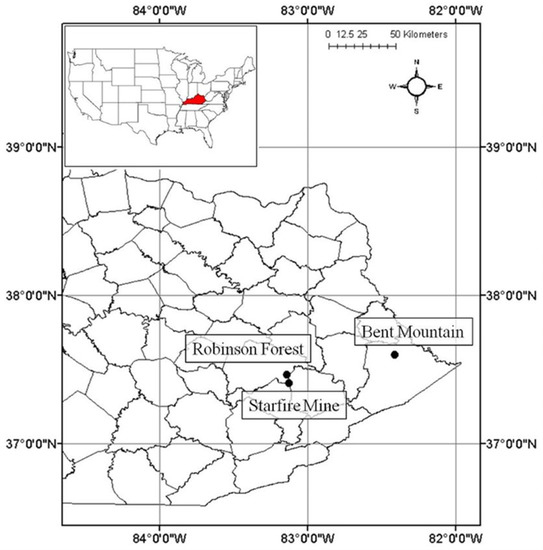
Figure 1.
Map showing location of reclaimed mine sites and control site in eastern Kentucky, USA.
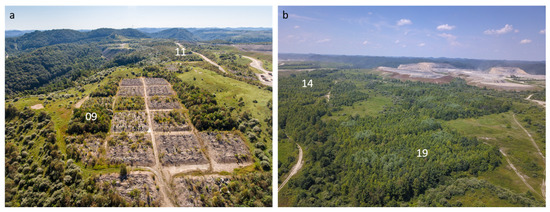
Figure 2.
Experimental brown weathered sandstone plots at Bent Mountain (a) and Starfire Mine (b). The age since planted are denoted as 9, 11, 14 and 19 years. The time 0 plot was also sampled at the Starfire Mine in a recently graded area depicted in the upper right of the picture, but not in view in this photo.
Samples were collected to a depth of 50 cm, where there were no impediments, using trenching in one trench per site. Trench walls were sampled at 2 cm intervals from 0 to 20 cm, and then at 5 cm intervals from 20 to 50 cm. Samples were oven-dried and visible stems, roots, and coal pieces were removed (to permit accurate determination of soil OC), and samples were then homogenized using a Retsch Mortar Grinder RM 200 (except for grain size aliquots; Retsch, Haan, Germany). Concentrations of Al, Mn, Fe, Mg, K, Ca, and Na were assessed by inductively coupled plasma mass spectrometry (ThermoFisher Element XR; ThermoFisher Scientific, Waltham, MA, USA) after samples were completely dissolved using concentrated acids (HF, HCl, and HNO3) over heat. Samples were diluted in ultrapure 0.16 M HNO3 (with 2 ppb In added as an internal standard). The dilution factor was chosen to bring analyte concentrations into the low mg kg−1 to µg·kg−1 range. Diluted samples were then analyzed using a high resolution ICPMS operated in medium resolution for all elements except K, which was determined in high resolution to eliminate interference from ArH+. Samples were introduced into the plasma using a PFA microflow nebulizer (Elemental Scientific, Inc., Omaha, NE, USA) connected to a PC3 Peltier cooled inlet system (Elemental Scientific). Calibration was by standard curve with the standards checked by comparison to a USGS standard reference sample.
Soil organic carbon (SOC) was measured using a LECO CHN 2000 (LECO, St. Joseph, MI, USA) analyzer after an acid pretreatment (HCl). δ13C (‰) was measured after HCl pretreatment (thus reflective of organic C only) on a Thermo-Finnigan Delta XP Isotope Ratio Mass Spectrometer (IRMS, ThermoFinnigan, Bremen, Germany). Particle size was assessed by quantifying the mineral grain size distribution, and sand, silt, and clay size fractions as defined by the Wentworth Scale [29]. These samples were dried at ~75 °C for 24–48 h, gently disaggregated, wet-sieved through 2 mm and 0.5 mm sieves, and treated with dilute H2O2 to destroy organic binding agents [30,31]. Samples were then analyzed using a Malvern Mastersizer S-2000 (Malvern Panalytical, Malvern, UK), a laser-optical particle size characterization instrument capable of accurately resolving particles over a size range of 0.02 to 2000 μm.
An assessment of tree growth and survival at the 19-year-old site was performed in the period 2015–2016 and results are presented in Dement et al. [12]. In an effort to quantify total carbon sequestration at these sites, tree biomass C was measured for each of three tree species planted in monoculture 0.04 ha strike-off plots (white pine, yellow poplar, and white oak) at the 19-year-old site. Sampled trees were randomly selected from plots of each species and included for harvesting if their diameter at a height of 1.4 m was within one standard deviation of the mean diameter for the plot. For yellow poplar and white oak, two individuals were destructively sampled from each of three plots (n = 6 for each species). For white pine, only one individual was destructively sampled per plot (n = 3), due to time constraints related to biomass partitioning. Trees were separated into leaves/needles, small branches, large branches, bole, and pine cones (for white pine only) and weighed. Subsamples of each category were dried in a walk-in oven (Lab-Line Instrument) at 60 °C for seven days and weighed. The subsample wet:dry weight ratio was used to convert field-weighed wet weight to dry weight. Subsamples were ground in a Wiley Mill to pass a 20-µm screen and analyzed for total C and N in a LECO CHN 2000 analyzer. Total aboveground biomass C (kg) was estimated at the plot scale as average biomass C/tree × total number of trees.
Associations of time since reclamation with concentrations of chemical species were evaluated by linear regression (using PROC GLM in SAS 9.4, SAS Institute, Cary, NC, USA) of data across depth intervals from 0 to 50 cm, including all mine sites (excluding the forest control site to prevent skew). To further evaluate patterns of soil development, especially with respect to particle size, the concentrations of all chemical species (across depth increments and sites) were tested for correlation with relative abundance of each particle size class using Pearson’s correlation. Finally, to better understand soil physical and chemical patterns with depth, data from the unmined forest control soil were analyzed for significant relationships with depth using linear regression (PROC GLM in SAS 9.4) and used as a reference for evaluating patterns in mine soils.
While the reclaimed mines sampled in this study were located in different sites, the potential for inter-site variability was considered slight, given that (1) reclaimed mine sites were constructed using the same techniques (FRA techniques) and (2) sites were constructed using overburden from the same formation (Breathitt Formation). Furthermore, both spatial replication (multiple sites reclaimed at the same time) and temporal replication (multiple times since reclamation within a site) were constrained by site availability—only a handful of sites in the region have been experimentally reclaimed using FRA techniques and are available for sampling. Given these limitations, the chronosequence approach implemented in this study was the most robust analytical approach possible.
3. Results
Mean soil characteristics (averaged across depths by site) are reported in Table 1, and parameter estimates and model fit statistics for regressions exploring relationships of chemical and physical characteristics with time since reclamation are displayed in Table S1 (Supplementary Materials).

Table 1.
Mean soil chemical and physical data (averaged across depth within sites, ± 1 SD), for mine soils collected from sites representing a chronosequence of time since reclamation, as well as a 100+ year-old forest soil (control).
3.1. Particle Size Distribution
Gravel and sand contents exhibited complex relationships with time since reclamation, with gravel contents decreasing from the fresh mine spoil to a minimum in the 9–11 year sites, then increasing in the 14- and 19-year-old sites (Table 1). Conversely, sand contents increased from fresh mine spoil to a maximum in the 9-year-old site, then decreased at the 11-year-old site, remained unchanged at the 14-year-old site, and decreased further at the 19-year-old site (Table 1). Silt and clay contents demonstrated weaker relationships with time, but silt generally increased with time since reclamation (from 0- to 11-year-old sites), and clay was highest in the 14-year-old site (Table 1).
3.2. Metals
Concentrations of Al, Mg, and K generally increased over time, and were similar to concentrations in the forest control soil at the 0–11-year-old sites; however, concentrations of Mg and K were mostly higher than in the forest control soil at the 14- and 19-year-old sites, and the Al concentration was higher than the forest control soil at the 19-year-old site (Table 1, Figure 3). Correlations of metal concentrations with particle size classes suggest that Al concentrations are negatively correlated with sand and positively correlated with clay (Table 2), consistent with incorporation of Al in aluminosilicate minerals; however, concentrations of Mg are positively correlated with gravel and negatively correlated with sand, Na concentrations are negatively correlated with gravel and clay and positively correlated with sand, and K concentrations were not significantly correlated with any particle size class (Table 2). Concentrations of Ca, Fe, and Mn exhibited complex relationships with time since reclamation (Table 2). Concentrations of Ca tended to be higher in mine soils than in the forest soil control, but Fe and Mn concentrations tended to be lower in mine soils. Concentrations of Ca were positively correlated with gravel, but negatively correlated with sand, silt, and clay (Table 2). Conversely, Mn was positively correlated with silt and clay, and Fe was negatively correlated with sand and positively correlated with clay (Table 2).
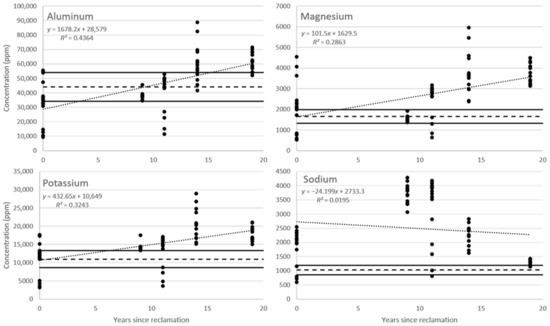
Figure 3.
Concentrations of aluminum, magnesium, sodium, and potassium across a chronosequence of mine soils, including data from all depth increments at each site. Dashed and solid lines represent mean concentrations ±1 SD for the reference forest soil.

Table 2.
Pearson’s correlation coefficients (r; df = 90) and p-values among soil analytes and soil particle size classes and organic matter, pooled across sites and depths (bold indicates p < 0.05).
3.3. Carbon
Percent OC averaged over depths by site generally increased over time since reclamation (Table 1), but exhibited high variability, especially at the 11- and 14-year-old sites and at the forest control site (Figure 4, Table 1). This variability is especially associated with depth, with a few particularly high OC concentrations in surface soils at these sites (Figure 5). While δ13C exhibited complex relationships with time since reclamation (δ13C was more depleted at the 9- and 11-year-old sites than at the 14- and 19-year-old sites), it was least depleted at the 0-year-old site and most depleted at the forest control site, suggesting a weak trend toward greater depletion with time since reclamation (Figure 4, Table 1). In addition, δ13C tended to be less depleted with depth (except in the 0-year-old site, which exhibited a consistent concentration across depth), consistent with % OC (Figure 6). Interestingly, Mn and Ca concentrations were strongly correlated with OC concentrations, suggesting that these metals may be forming organometal complexes in these soils (Table 2).

Figure 4.
Percent organic carbon and δ13C (‰) across a chronosequence of mine soils, including data from all depth increments at each site. Dashed and solid lines represent mean concentrations ±1 SD for the reference forest soil.
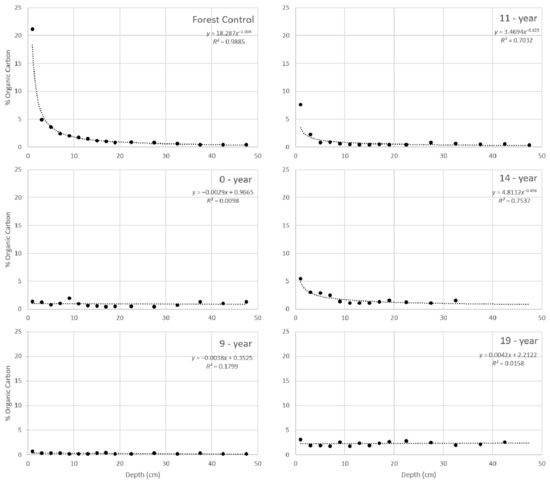
Figure 5.
Percent organic carbon varies with depth across a chronosequence of reclaimed mine sites ranging from 0 to 19 years, with a 100+ year forest soil control.
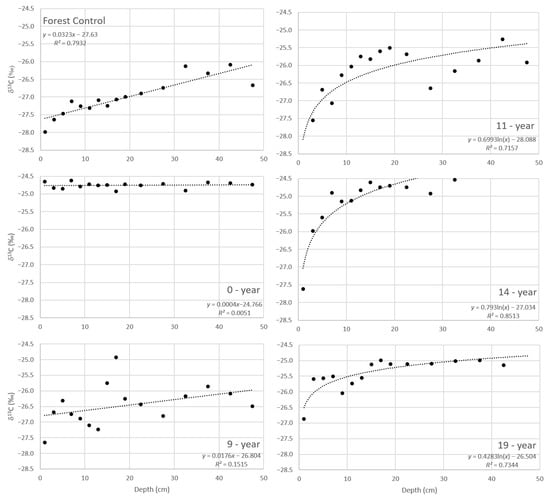
Figure 6.
Concentrations of δ13C vary with depth across a chronosequence of reclaimed mine sites ranging from 0 to 19 years, with a 100+ year forest soil control.
Alongside OC accumulation in soils, tree biomass at the 19-year-old site demonstrated significant OC storage, with total OC storage in tree biomass estimated at 25.8 Mg/ha (White Oak), 66.1 Mg/ha (White Pine), and 42.8 Mg/ha (Yellow Poplar), and annual OC sequestration rates ranging from 1.44 to 3.67 Mg/ha/yr (Table 3).

Table 3.
Aboveground OC sequestration values for a reclaimed site 19 years after reclamation.
3.4. Depth Analysis
Generally, gravel contents declined with depth, while silt and clay contents increased with depth. Sand contents demonstrated more complex relationships with depth, increasing through the first 20 cm, then becoming relatively steady or decreasing thereafter (Figure 7). Concentrations of Mn and Ca generally decreased with depth, while Fe concentrations did not exhibit significant relationships with depth (Figure 8). Conversely, concentrations of Al, Mg, and K increased with depth (Figure 8). Percent OC decreased exponentially through the top ten cm, but then decreased gradually and linearly with depth (Figure 9). Similarly, δ13C was most depleted in near-surface soils, and became less depleted with depth (Figure 9).
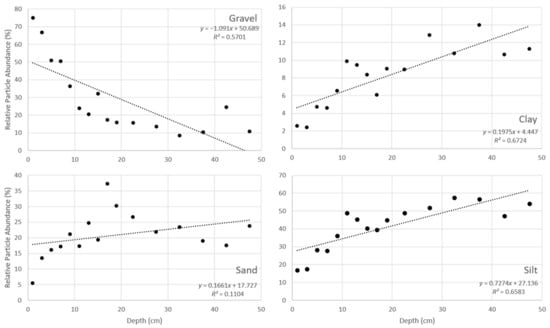
Figure 7.
Particle size distribution in depth increments in a 100+ year old forest soil.
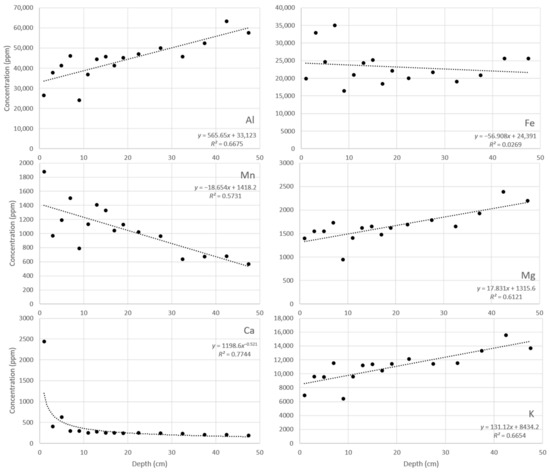
Figure 8.
Concentrations of Al, Mn, Ca, Fe, Mg, and K over depth increments in a 100+ year old forest soil.

Figure 9.
Organic carbon (%) and δ13C (‰) over depth increments in a 100+ year old forest soil.
Several elements demonstrated similar patterns of change in concentrations with depth over time. For instance, Ca concentrations at time zero were lowest at the surface and increased with depth, but at the 11–19 year sites exhibited the opposite pattern with depth—higher concentrations in near-surface soils with concentrations fairly stable with depth (Figure 10).
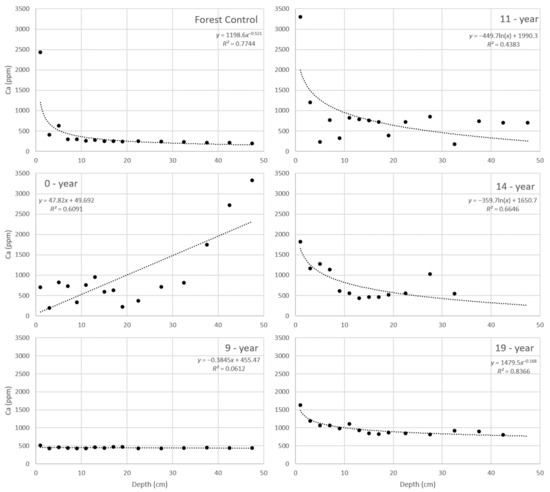
Figure 10.
Concentrations of Ca vary with depth across a chronosequence of reclaimed mine sites ranging from 0 to 19 years, compared to a 100+ year forest soil control.
4. Discussion
4.1. Particle Size Distribution
Soils at the reclaimed mine sites tended toward increasing gravel and decreasing sand contents over time since reclamation, as well as generally increasing silt and clay contents; however, trends in clay and silt were weak. Particle size distributions in mine soils were similar to the particle size distribution observed in the forest soil for each size class, but, the trend from 14- to 19-year-old sites suggested that particle size distribution (for all size classes except silt) in mine soils might become less similar to forest soils into the future. The differences in gravel content between the 9–11 year sites and the 14–19 year sites could be related to initial spoil placement. The strike-off method [28] was attempted for the first time at the 19-year-old site and the grading technique resulted in an uneven surface that contained many large boulders and voids. Similarly, the 14-year-old site was strike-off graded by the same mining company and the final landscape was uneven. The 9- and 11-year-old sites were developed by a different mining company who had performed strike-off reclamation several times previously, and they produced a final surface that contained fewer boulders and appeared less uneven. As such, differences in gravel contents are likely attributable to differences in how the plots were constructed. Increases in silt and clay contents over time are crucial for soil functions, especially moisture and nutrient retention [33,34]—functions which are critical at reclaimed mine sites, which are often characterized by soil moisture and chemical conditions that are unfavorable for plant growth [9,16]. However, other studies that have investigated mine soil development in this region have not reported strong trends in soil fine-grained sediment accumulation over ~10 year time scales [15,16], emphasizing the importance of longer-term studies (>10 yr.).
4.2. Metals
Metals are released into the developing soil matrix as regolith is chemically weathered; however, low initial CEC leads to base oversaturation and loss of cations by leaching via interflow. Several studies have reported rapid weathering in newly placed mine spoils, leading to base oversaturation in soils (e.g., [15]) and high concentrations of cations in interflow (e.g., [19]). Over time, as CEC develops (driven by accumulation of OM and soil fines) and weathering rates stabilize, cation concentrations in interflow decrease, and soil cation exchange sites become undersaturated [35]. In this study, Al, K, and Mg concentrations generally increased with time since reclamation, while Na concentrations increased to a maximum in mine soils of intermediate age (10–12 yr.) and decreased to a minimum in the forest control soil. Increasing concentrations of Al, Mg, and K could be related to the incorporation of these metals into developing soil minerals; however, only Al concentrations were positively correlated with clay-sized content, suggesting that this increasing trend is more complex than accumulation of soil fines. Rather, given that these metals are continuing to increase in concentration past typical concentrations in forest soils, this pattern may indicate that these metals are continuing to be released by ongoing mineral weathering, and may be adsorbing to soil fines (silt and clay) and OM, as well as being incorporated into soil minerals. Further work on these sites is necessary to more fully characterize soil mineral development and sorption dynamics. In contrast, the somewhat tidier pattern exhibited by Na conforms more neatly to the expected pattern of rapid mineral weathering at “young” sites (0–11 years), followed by loss via leaching, resulting in lower concentrations over time. The recovery of Na concentrations similar to forest soils at the 19-year-old site suggests that Na concentrations may be reaching a stable equilibrium at this site.
4.3. Carbon
Because surface-mined sites in Appalachia are frequently reclaimed with crushed overburden rather than native pre-mining soils, surface “soils” are typically devoid of OM at the time of reclamation. Soil OM plays crucial roles in soil aggregate formation [36] and microbial community development [37], as well as in the development of soil nutrient [38,39] and water holding capacities [40]; thus, accumulation of OM is of interest for soil health [41]. In addition, given their low starting OC stocks, these developing soils are important for carbon sequestration and associated natural climate change mitigation benefits (e.g., [42]). As noted by Amichev et al. [24], reforested surface mine sites of varying ages and forest types stored 117–148 Mg/ha of OC (including tree biomass, SOC, and litter layer carbon), and forests on reclaimed mine sites were projected to store up to 168 Mg/ha of OC at a stand age of 60 years. While less than the 205 Mg/ha of OC storage Amichev et al. [24] reported for unmined forests in the region, this still represents an important opportunity to store OC in Appalachia. In this study, average soil OC concentrations demonstrated an increasing trend with time since reclamation, with average concentrations at the 14- and 19-year-old sites approaching the average at the forest control site. The general trend of increasing δ13C depletion from least depleted in the fresh mine spoil (minimal OC), through the chronosequence to most depleted at the forest control site (highest OC), supports the attribution of this pattern in OC accumulation to development of “new” OC, rather than to coal fragments or carbonate minerals, which can overinflate carbon estimates at these sites if not accounted for [26].
Accumulation of OC in soil over the chronosequence is complemented by significant sequestration of OC in aboveground biomass. While all sites involved in this study were planted with native trees at the time of reclamation, in accordance with the FRA, aboveground biomass in trees was only evaluated at the 19-year-old site. White pine (mean height = 13.9 m), white oak (mean height = 10.2 m) and yellow poplar (mean height = 13.7 m) all exhibited excellent growth at this site (Table 3 [12]), consistent with other published reports of tree growth on FRA-reclaimed sites in this area, such as average height >5.1 m for white oak after 10 years [15] and >4.1 m for yellow poplar after 9 years [16]. Similarly, estimated aboveground OC storage (25–66 Mg/ha) at the 19-year-old site was consistent with 48.9 Mg/ha tree OC reported by Avera et al. [25] at a 21-year-old site in western Virginia. Taken together, with the 17.3 Mg/ha of OC stored in soils in white oak plots (see [32]), these data demonstrate total ecosystem OC (conservatively estimated) exceeding 43 Mg/ha in white oak plots, and likely much higher in white pine and yellow poplar plots, contributing to the literature demonstrating the significant OC storage potential of surface-mined sites.
4.4. Concentration Changes by Time and Depth
Several parameters demonstrated similar trends of change in concentrations with depth over time. For instance, Ca concentrations at time zero were lowest at the surface and increased with depth, but concentrations of Ca tended to be highest in near-surface soils and stable with increasing depth at the 11–19 year sites. As noted above with respect to the correlation analysis, this pattern could be related to cation sorption to OM or to clay minerals, or to formation of discrete mineral precipitates common in mine spoils and waters [43,44] near the surface, while weathering and leaching continues in deeper soil resulting in a depletion of these elements [19,35]. It is also notable that the shape of the trend lines for Ca for the 11–19 year sites is similar to that observed for the forest control, suggesting that Ca profiles in these sites are becoming more stable over time (Figure 10).
It is difficult to predict the influence of reforestation and time on particle and metal distributions in mine soils. However, research has shown that we can expect increased OC concentrations in mine soils as planted forests grow and mature [15,26,27]. Interestingly, examining changes in OC profiles across chronosequences, we see that OC is fairly evenly distributed across depth at time zero but becomes higher near the surface and lower with depth over time (Figure 5). As expected, this corresponds to a depletion of δ13C with depth over time. This pattern reflects observable changes to the site as the forest matures. In early years after planting, the sites had an open canopy allowing sunlight penetration to the forest floor, low moisture, high decomposition, and no litter layer development. Canopy closure at these sites happened around year nine. Once the canopy closes, forest floor conditions change rapidly. Shade, increased soil moisture, and protection from the wind allows leaves to accumulate and begin to decompose (while open canopy conditions existed, wind would blow fallen leaves off of the experimental plots). Moreover, when the sites were planted, there was no woody debris on the soil surface. As time progressed, trees would compete with each other for resources and some would be outcompeted and die, wind and ice resulted in limbs falling off trees, disease and insects resulted in additional tree mortality, and ultimately by year 19, a relatively complex forest floor had developed. Development of this forest floor is key to the accumulation of OC in surface soils. Not only does it promote soil OC sequestration, but the added OC can stimulate soil fauna and contribute to furthering soil genesis in these young soils.
5. Conclusions
This study characterizes patterns of soil development over a chronosequence of mine soils ranging from 0 years (fresh mine spoil) to 19 years after reclamation, in comparison with soil from an adjacent unmined forest control site, which is ~100 years old (since most recent logging). While soil particle sizes demonstrated complex relationships with time, the general increase in soil fine particle contents over time suggests that these soils are on a trajectory moving towards levels of fine particles found in native forest soils. However, given the complexity of these patterns and the weakness of the relationships (especially with clay-sized particles), further research is needed to continue to track especially clay-size particle accumulation over time. Similarly, while concentrations of metals exhibited complex relationships with time, the continued accumulation of some metals (Al, Mg, and K) suggest that mineral weathering (releasing metals from mineral complexes) and sorption (metals adsorbing to soil mineral and organic particle surfaces) dynamics for these metals will require more than 19 years to equilibrate. In contrast, the relatively smooth pattern observed for Na suggests that this element may equilibrate more rapidly. Finally, accumulation of soil and aboveground biomass OC over time demonstrates the significant potential of developing mine soils for OC sequestration—increasingly important in the face of unmitigated climate change.
Supplementary Materials
The following are available online at https://www.mdpi.com/article/10.3390/min11040422/s1: Table S1. Linear regression model parameter estimates for soil chemical and physical characteristics by time since reclamation.
Author Contributions
Conceptualization, C.D.B., K.M.Y. and J.M.L.; methodology, C.D.B., K.M.Y. and J.M.L.; formal analysis, K.L.S., K.M.Y. and C.D.B.; investigation, W.E.B. and K.J.S.; resources, C.D.B., K.M.Y. and J.M.L.; data curation, C.D.B., K.M.Y. and K.L.S.; writing—original draft preparation, K.L.S., K.M.Y. and C.D.B.; writing—review and editing, K.L.S., K.M.Y., C.D.B. and J.M.L.; visualization, K.L.S. and C.D.B.; supervision, C.D.B., K.M.Y. and J.M.L.; project administration, C.D.B., K.M.Y. and J.M.L.; funding acquisition, C.D.B. All authors have read and agreed to the published version of the manuscript.
Funding
This research was funded by the USDI Office of Surface Mining Reclamation and Enforcement’s Applied Science Program (Grant #S15AC20026). APC was supported by Sena’s Storkan-Hanes-McCaslin Award and Barton’s general funds.
Institutional Review Board Statement
Not applicable.
Informed Consent Statement
Not applicable.
Data Availability Statement
Not applicable.
Acknowledgments
We thank Joe Frederick, Chase Clark, Alicia Wood, Dan Eaton, Cory Schuler, Taylor Childress, Courtney Gover, and Tiffany Heim for field assistance.
Conflicts of Interest
The authors declare no conflict of interest.
References
- Wickham, J.; Wood, P.B.; Nicholson, M.C.; Jenkins, W.; Druckenbrod, D.; Suter, G.W.; Strager, M.P.; Mazzarella, C.; Galloway, W.; Amos, J. The Overlooked Terrestrial Impacts of Mountaintop Mining. BioScience 2013, 63, 335–348. [Google Scholar] [CrossRef]
- Ross, M.R.V.; McGlynn, B.L.; Bernhardt, E.S. Deep Impact: Effects of Mountaintop Mining on Surface Topography, Bedrock Structure, and Downstream Waters. Environ. Sci. Technol. 2016, 50, 2064–2074. [Google Scholar] [CrossRef] [PubMed]
- Pericak, A.A.; Thomas, C.J.; Kroodsma, D.A.; Wasson, M.F.; Ross, M.R.V.; Clinton, N.E.; Campagna, D.J.; Franklin, Y.; Bernhardt, E.S.; Amos, J.F. Mapping the yearly extent of surface coal mining in Central Appalachia using Landsat and Google Earth Engine. PLoS ONE 2018, 13, e0197758. [Google Scholar] [CrossRef] [PubMed]
- Petty, J.T.; Fulton, J.B.; Strager, M.P.; Merovich, G.T., Jr.; Stiles, J.M.; Ziemkiewicz, P.F. Landscape indicators and thresholds of stream ecological impairment in an intensively mined Appalachian watershed. J. of the North Am. Benthol. Soc. 2010, 29, 1292–1309. [Google Scholar] [CrossRef]
- Bernhardt, E.S.; Lutz, B.D.; King, R.S.; Fay, J.P.; Carter, C.E.; Helton, A.M.; Campagna, D.; Amos, J. How Many Mountains Can We Mine? Assessing the Regional Degradation of Central Appalachian Rivers by Surface Coal Mining. Environ. Sci. Technol. 2012, 46, 8115–8122. [Google Scholar] [CrossRef]
- Maigret, T.A.; Cox, J.J.; Yang, J. Persistent geophysical effects of mining threaten ridgetop biota of Appalachian forests. Front. Ecol. Environ. 2019, 17, 85–91. [Google Scholar] [CrossRef]
- Angel, P.; Davis, V.; Burger, J.; Graves, D.; Zipper, C. Chapter 1: The Appalachian regional reforestation initiative. In The Forestry Reclamation Approach: Guide to Successful Reforestation of Mined Lands. Gen. Tech. Rep. NRS-169; Adams, M.-B., Ed.; U.S. Department of Agriculture, Forest Service, Northern Research Station: Newtown Square, PA, USA, 2017; pp. 1-1–1-4. [Google Scholar]
- Reed, M.; Kite, S. Peripheral gully and landslide erosion on an extreme anthropogenic landscape produced by mountaintop removal coal mining. Earth Surf. Process. Landf. 2020, 45, 2078–2090. [Google Scholar] [CrossRef]
- Zipper, C.E.; Burger, J.A.; McGrath, J.M.; Rodrigue, J.A.; Holtzman, G.I. Forest Restoration Potentials of Coal-Mined Lands in the Eastern United States. J. Environ. Qual. 2011, 40, 1567–1577. [Google Scholar] [CrossRef]
- Skousen, J.; Zipper, C.; Burger, J.; Barton, C.; Angel, P. Chapter 3: Selecting materials for mine soil construction when establishing forests on Appalachian mined lands. In The Forestry Reclamation Approach: Guide to Successful Reforestation of Mined Lands. Gen. Tech. Rep. NRS-169; Adams, M.-B., Ed.; U.S. Department of Agriculture, Forest Service, Northern Research Station: Newtown Square, PA, USA, 2017; pp. 3-1–3-10. [Google Scholar]
- Feng, Y.; Wang, J.; Bai, Z.; Reading, L. Effects of surface coal mining and land reclamation on soil properties: A review. Earth-Science Rev. 2019, 191, 12–25. [Google Scholar] [CrossRef]
- Dement, W.T.; Hackworth, Z.J.; Lhotka, J.M.; Barton, C.D. Plantation development and colonization of woody species in response to post-mining spoil preparation methods. New For. 2020, 51, 965–984. [Google Scholar] [CrossRef]
- Adams, M.-B. (Ed.) The Forestry Reclamation Approach: Guide to Successful Reforestation of Mined Lands. Gen. Tech. Rep. NRS-169; U.S. Department of Agriculture, Forest Service, Northern Research Station: Newtown Square, PA, USA, 2017; 128p.
- Miller, J.; Barton, C.; Agouridis, C.; Fogel, A.; Dowdy, T.; Angel, P. Evaluating Soil Genesis and Reforestation Success on a Surface Coal Mine in Appalachia. Soil Sci. Soc. Am. J. 2012, 76, 950–960. [Google Scholar] [CrossRef]
- Sena, K.; Agouridis, C.; Miller, J.; Barton, C. Spoil Type Influences Soil Genesis and Forest Development on an Appalachian Surface Coal Mine Ten Years after Placement. Forests 2018, 9, 780. [Google Scholar] [CrossRef]
- Sena, K.; Barton, C.; Hall, S.; Angel, P.; Agouridis, C.; Warner, R. Influence of spoil type on afforestation success and natural vegetative recolonization on a surface coal mine in Appalachia, United States. Restor. Ecol. 2015, 23, 131–138. [Google Scholar] [CrossRef]
- Wilson-Kokes, L.; Delong, C.; Thomas, C.; Emerson, P.; O’Dell, K.; Skousen, J. Hardwood Tree Growth on Amended Mine Soils in West Virginia. J. Environ. Qual. 2013, 42, 1363–1371. [Google Scholar] [CrossRef]
- Wilson-Kokes, L.; Emerson, P.; Delong, C.; Thomas, C.; Skousen, J. Hardwood Tree Growth after Eight Years on Brown and Gray Mine Soils in West Virginia. J. Environ. Qual. 2013, 42, 1353–1362. [Google Scholar] [CrossRef]
- Agouridis, C.T.; Angel, P.N.; Taylor, T.J.; Barton, C.D.; Warner, R.C.; Yu, X.; Wood, C. Water Quality Characteristics of Discharge from Reforested Loose-Dumped Mine Spoil in Eastern Kentucky. J. Environ. Qual. 2012, 41, 454–468. [Google Scholar] [CrossRef]
- Orndorff, Z.W.; Daniels, W.L.; Zipper, C.E.; Eick, M.; Beck, M. A column evaluation of Appalachian coal mine spoils’ temporal leaching behavior. Environ. Pollut. 2015, 204, 39–47. [Google Scholar] [CrossRef]
- Daniels, W.; Zipper, C.; Orndorff, Z.; Skousen, J.; Barton, C.; McDonald, L.; Beck, M. Predicting total dissolved solids release from central Appalachian coal mine spoils. Environ. Pollut. 2016, 216, 371–379. [Google Scholar] [CrossRef]
- Haering, K.C.; Daniels, W.L.; Galbraith, J.M. Appalachian mine soil morphology and properties: Effects of weathering and mining method. Soil Sci. Soc. Am. J. 2004, 68, 1315–1325. [Google Scholar] [CrossRef]
- Nash, W.L.; Daniels, W.L.; Haering, K.C.; Burger, J.A.; Zipper, C.E. Long-term Effects of Rock Type on Appalachian Coal Mine Soil Properties. J. Environ. Qual. 2016, 45, 1597–1606. [Google Scholar] [CrossRef] [PubMed]
- Amichev, B.Y.; Burger, J.A.; Rodrigue, J.A. Carbon sequestration by forests and soils on mined land in the Midwestern and Appalachian coalfields of the U.S. For. Ecol. Manag. 2008, 256, 1949–1959. [Google Scholar] [CrossRef]
- Avera, B.N.; Strahm, B.D.; Burger, J.A.; Zipper, C.E. Development of ecosystem structure and function on reforested surface-mined lands in the Central Appalachian Coal Basin of the United States. New For. 2015, 46, 683–702. [Google Scholar] [CrossRef]
- Maharaj, S.; Barton, C.D.; Karathanasis, T.A.; Rowe, H.D.; Rimmer, S.M. Distinguishing “new” from “old” organic carbon in reclaimed coal mine sites using thermogravimetry: II. Field validation. Soil Sci. 2007, 172, 302–312. [Google Scholar] [CrossRef]
- Littlefield, T.; Barton, C.; Arthur, M.; Coyne, M. Factors controlling carbon distribution on reforested minelands and regenerating clearcuts in Appalachia, USA. Sci. Total. Environ. 2013, 465, 240–247. [Google Scholar] [CrossRef] [PubMed]
- Sweigard, R.; Burger, J.; Zipper, C.; Skousen, J.; Barton, C.; Angel, P. Chapter 4: Low compaction grading to enhance reforestation success on coal surface mines. In The Forestry Reclamation Approach: Guide to Successful Reforestation of Mined Lands. Gen. Tech. Rep. NRS-169; Adams, M.-B., Ed.; U.S. Department of Agriculture, Forest Service, Northern Research Station: Newtown Square, PA, USA, 2017; pp. 4-1–4-8. [Google Scholar]
- Wentworth, C.K. A Scale of Grade and Class Terms for Clastic Sediments. J. Geol. 1922, 30, 377–392. [Google Scholar] [CrossRef]
- Hillier, S. Particulate composition and origin of suspended sediment in the R. Don, Aberdeenshire, UK. Sci. Total. Environ. 2001, 265, 281–293. [Google Scholar] [CrossRef]
- Yeager, K.M.; Santschi, P.H.; Phillips, J.D.; Herbert, B.E. Suspended sediment sources and tributary effects in the lower reaches of a coastal plain stream as indicated by radionuclides, Loco Bayou, Texas. Environ. Earth Sci. 2005, 47, 382–395. [Google Scholar] [CrossRef]
- Sena, K.L.; Yeager, K.M.; Dreaden, T.J.; Barton, C.D. Phytophthora cinnamomi Colonized Reclaimed Surface Mined Sites in Eastern Kentucky: Implications for the Restoration of Susceptible Species. Forests 2018, 9, 203. [Google Scholar] [CrossRef]
- Gupta, S.C.; Larson, W.E. Estimating soil water retention characteristics from particle size distribution, organic matter percent, and bulk density. Water Resour. Res. 1979, 15, 1633–1635. [Google Scholar] [CrossRef]
- Dempster, D.N.; Jones, D.L.; Murphy, D.V. Clay and biochar amendments decreased inorganic but not dissolved organic nitrogen leaching in soil. Soil Res. 2012, 50, 216–221. [Google Scholar] [CrossRef]
- Sena, K.; Barton, C.D.; Angel, P.N.; Agouridis, C.T.; Warner, R.C. Influence of Spoil Type on Chemistry and Hydrology of Interflow on a Surface Coal Mine in the Eastern US Coalfield. Water Air Soil Pollut. 2014, 225, 1–14. [Google Scholar] [CrossRef]
- Jastrow, J. Soil aggregate formation and the accrual of particulate and mineral-associated organic matter. Soil Biol. Biochem. 1996, 28, 665–676. [Google Scholar] [CrossRef]
- Bending, G.D.; Turner, M.K.; Jones, J.E. Interactions between crop residue and soil organic matter quality and the functional diversity of soil microbial communities. Soil Biol. Biochem. 2002, 34, 1073–1082. [Google Scholar] [CrossRef]
- Castellano, M.J.; Lewis, D.B.; Kaye, J.P. Response of soil nitrogen retention to the interactive effects of soil texture, hydrology, and organic matter. J. Geophys. Res. Biogeosciences 2013, 118, 280–290. [Google Scholar] [CrossRef]
- Fuss, C.B.; Lovett, G.M.; Goodale, C.L.; Ollinger, S.V.; Lang, A.K.; Ouimette, A.P. Retention of Nitrate-N in Mineral Soil Organic Matter in Different Forest Age Classes. Ecosystems 2019, 22, 1280–1294. [Google Scholar] [CrossRef]
- Hudson, B.D. Soil organic matter and available water capacity. J. soil Water Conserv. 1994, 49, 189–194. [Google Scholar]
- Murphy, B.W. Impact of soil organic matter on soil properties—a review with emphasis on Australian soils. Soil Res. 2015, 53, 605–635. [Google Scholar] [CrossRef]
- Griscom, B.W.; Adams, J.; Ellis, P.W.; Houghton, R.A.; Lomax, G.; Miteva, D.A.; Schlesinger, W.H.; Shoch, D.; Siikamäki, J.V.; Smith, P.; et al. Natural climate solutions. Proc. Natl. Acad. Sci. USA 2017, 114, 11645–11650. [Google Scholar] [CrossRef]
- Barton, C.D.; Karathanasis, A.D. Aerobic and Anaerobic Metal Attenuation Processes in a Constructed Wetland Treating Acid Mine Drainage. Environ. Geosci. 1998, 5, 43–56. [Google Scholar] [CrossRef]
- Barton, C.; Paddock, L.; Romanek, C.; Maharaj, S.; Seaman, J. Metal attenuation processes in a landfill containing coal combustion waste: Implications for remediation. Environ. Geosci. 2005, 12, 45–55. [Google Scholar] [CrossRef]
Publisher’s Note: MDPI stays neutral with regard to jurisdictional claims in published maps and institutional affiliations. |
© 2021 by the authors. Licensee MDPI, Basel, Switzerland. This article is an open access article distributed under the terms and conditions of the Creative Commons Attribution (CC BY) license (https://creativecommons.org/licenses/by/4.0/).